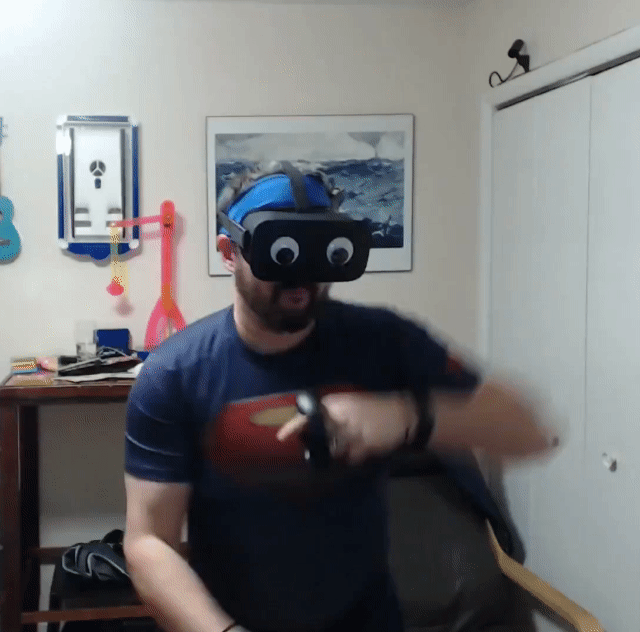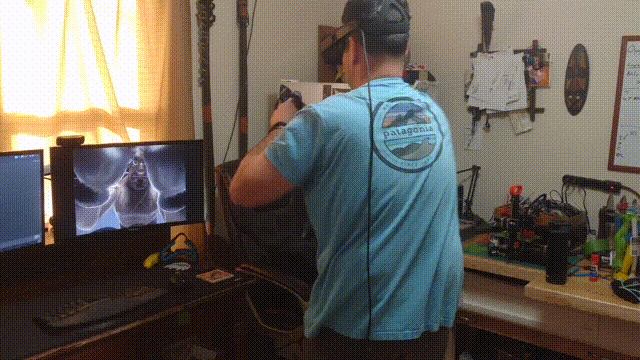For the last several years, I’ve been working off the weight gained and fitness lost from a decade of grad school, post-doctoral research, job hunting, and, ultimately, launching my own company. The gym, to put it mildly, had not been a priority. Running and weight training went a long way towards getting me back to where I wanted to be, but I had hit a plateau. Every spring and summer I’d make incremental improvements, every winter, I’d fall back into old habits. It was a sustainable situation, but not fantastic.
Last summer, I set a goal for myself. While the weather was just on the wrong side of that threshold that makes running something I’m willing to do first thing in the morning, I would instead swap out my sneakers for an Oculus Rift, and spend an hour, four or five days a week, playing fitness-oriented virtual reality games, for fifty sessions. That schedule would get me through the winter and hopefully keep me more active than I otherwise would.
To better illustrate this plan, I made a GIF, just for you:

Unsurprisingly, the science behind Virtual Reality and exercise is still in its infancy.
The Virtual Reality Institute of Health and Exercise maintains a running database of VR games and their relative fitness scores. They use metabolic equivalent of task scores to assess how intensive each game is and them rank them compared to other physical activities.
Beat Saber, for example, is roughly equivalent to a game of tennis, while Thrill of the Fight, which I can attest lays you out flat after 20-minutes in the game, is closer to rowing.
The fact that these games are active, rather than passive, is a big part of why they work well for exercise, but they don’t tell the whole story. The few studies that do exist show that not only do VR games get you moving and motivated, but that Virtual Reality also decreases the experience of exercise-related pain and alters your perception of time. In other words, working out in VR means it takes longer to feel sore and you spend more time playing. Both of which help you workout longer at higher intensities.
There are, of course, other clinical applications for VR, including assisting in pain management, distraction patients during long and onerous procedures, and helping kids cope with painfully procedures. There are also studies suggesting the potential for cognitive improvements from using VR, but, again, the science is in its infancy and almost every study is extremely preliminary.
What is relatively well-established is that waving your hands in the air like a giant dork for an hour burns calories.

So, how did it go? Over three months I worked out pretty intensely, initially with a short low-intensity warm-up like Quivr or Robo Recall, followed by Beat Saber and then either Thrill of the Fight or Knockout League. Towards the end I ended up favoring the boxing games pretty heavily, as they are, by far, the most intense workouts available in VR. That shouldn’t be a surprise. Shadow boxing has always been a pretty solid workout, and VR makes it easy to push through the fatigue and go a little longer than normal.
Some days I used a weighted vest, other days I uses weighted gloves, sometimes I used both. You have to be careful with weighted gloves, though, as erratic movements can do serious damage to your joints. On those days I stuck to more predictable games like Beat Saber and Knockout League.
I went into this averaging a weight of 212 lbs. I closed out the 50-day run at 196. Three months later, I’ve been averaging a steady 198 lbs. All told, I lost 14 lbs doing exercise in virtual reality, but, more importantly, I lost weight during a season where I usually gain a few pounds. For me, that’s a huge win.

I’m pretty darn happy with the results. If I had had access to a VR system in graduate school, I almost certainly wouldn’t need to be burning off the accumulated baggage of a thesis and post-doc (not to mention launching my own company). VR takes advantage of all of my weaknesses–in particular the ease with which I get sucked into video games–to get me up and moving.
My original motivation for rigging up a virtual reality system was to assess the potential to build virtual conference spaces to reduce the climate impact of global conservation conferences. If we could bring delegations together to set priorities for a greener future without dragging hundreds of people to the world’s far flung corners, that would be a huge reduction in the climate impact of conservation work. VR for exercise meets that same goal, on a smaller scale. My nearest gym is 15 miles away. Being able to dive into intense, high impact workouts without leaving my relatively spartan office cuts out a 30-mile round trip (and saves me a half hour commute).
For all the talk of awesome, immersive games (Skyrim in VR is mind-blowing) and the potential for virtual conferences (we’re still working on that), I think the real surprise killer application for virtual reality is going to be in the fitness world. It makes a ton of sense and with the new stand-alone Oculus Quest coming out, which is relatively under-powered but has no cord to trip up and doesn’t require a beefy computer to run, putting a VR gym in your home lands around the same cost as a fairly mediocre treadmill.
Virtual Reality is in a moment of transition right now. Oculus is releasing it’s next-generation Rift as well as the Quest later this month, and companies like HP and Valve are releasing their own platforms. Its an exciting time to get in on the action, but can be overwhelming for someone just diving in.
When I was posting result during the 50-day fitness challenge a few months back, several folks asked which system I recommended, and my honest answer was, don’t invest now, wait for the Oculus Quest to come out and get some reviews. I still stand by that. The Quest won’t run massive VR adventure games, but it will do the smaller fitness games just fine, and without a cord. Plus, if you don’t have a big gaming desktop to run a full VR system, that’s another $1000 expense on top of the headset and sensors.
The Quest is a single, $400 system that covers everything. And it’s out next Tuesday. I have one coming and will add my review once I beat it up for a week or two.
My Set-Up. I have a heavily-modified Alienware x51 with a GTX 970 graphics card and an Intel i7 processor. It works great and doesn’t draw much power (for a desktop computer). At the end of the day, your best bet for a low-cost VR-capable PC is going to be to build it yourself, but if that’s not your thing, Oculus maintains a list of Rift-ready PCs. I’m running a first-generation Oculus Rift with an extra sensor for better tracking. If I were building a new system today, I’d probably get a Rift S, which doesn’t need any sensors, but the VR-space is expanding rapidly and there are a lot of great options to choose from, now.
I also use this weighted vest, which is pretty comfortable for bouncing around in VR, and these weighted gloves, which are the only ones of the dozens I tried that fit well and let you use the controllers comfortably. I really recommend weighted glove over wrist weights as they seem to put a lot less strain on my shoulders and elbows.
Southern Fried Science is free and ad-free (other than the occasional use of Amazon Affiliate links when we talked about consumer products). If you enjoy Southern Fried Science, consider contributing to our Patreon campaign.